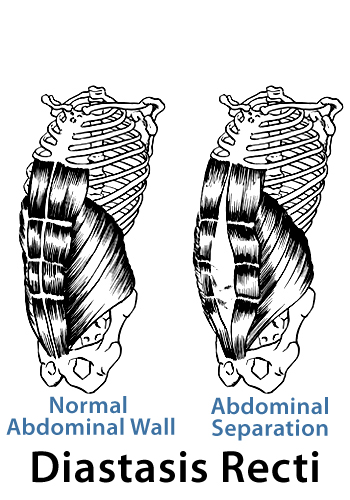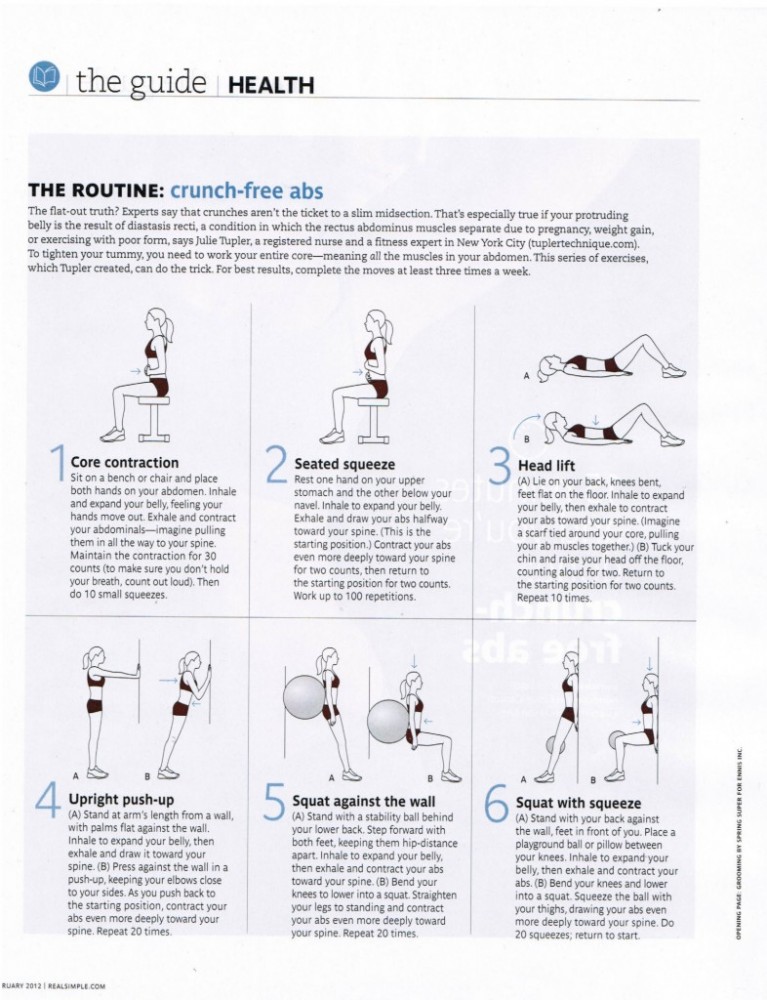
What is Diastasis Recti?
Diastasis recti is a medical condition that causes a separation of the muscles that cover your abdomen. This most commonly occurs following pregnancy because the growing baby places excess strain on the abdominal muscles. If you experience diastasis recti, your stomach may appear as if a ridge is running down your midsection. This condition most often heals on its own, and exercise can help to strengthen the abdominal muscles and reduce the appearance of diastasis recti. Check with your physician before beginning an exercise program after giving birth.


How to check yourself for DA
- Lie on your back with both knees bent.
- Place four fingers of left hand above belly button, and right hand below your belly button, all along your midline.
- Raise your head and shoulders off floor as if you are attempting a crunch.
- Is there a vertical separation of the rectus abdominis muscle, causing a gap of the muscles, and/or a bulge to appear? If so, where does the separation occur–above or below the belly button or in a combination of these locations? Now place four fingers, pointing toward feet, in the area of separation.
- Raise your head and shoulders off floor, reaching left hand out toward feet. How many fingers can you place in the gap, one – two – three – four? Placing one to two fingers in the gap is normal. If you can place more than two fingers in the gap, you have diastasis recti.




Exercises to help treat DA
Hand Guidance
This exercise involves using your hands to knit your abdominal muscles together in the correct position. To perform, lie on your back with your feet on the ground. Cross your hands over each other, placing one hand on each side of your abdominal muscles. Inhale, then slowly breathe out and raise only your head off the ground. As you lift up, gently guide your stomach muscles together. If you prefer, you can wrap a sheet or towel around your stomach and pull the ends together to guide the stomach muscles. Lower your head to your starting position and repeat 10 times. Perform an additional two sets throughout the day.
This exercise involves using your hands to knit your abdominal muscles together in the correct position. To perform, lie on your back with your feet on the ground. Cross your hands over each other, placing one hand on each side of your abdominal muscles. Inhale, then slowly breathe out and raise only your head off the ground. As you lift up, gently guide your stomach muscles together. If you prefer, you can wrap a sheet or towel around your stomach and pull the ends together to guide the stomach muscles. Lower your head to your starting position and repeat 10 times. Perform an additional two sets throughout the day.
Heel Slide
This exercise works the transverse abdominis, the muscle group compromised during diastasis recti. Lie on your back with your feet on the ground. You may wish to place your hands, palms down, under your buttocks for additional support. Lift your toes off the ground, leaving only your heel on the floor. Gently slide this foot out to straighten your leg. Hold the straight-leg position for five seconds, then slide the leg back in toward you. Repeat the exercise eight times, then perform on the opposite leg.
Pelvic Tilt
This gentle exercise helps to strengthen your abdominal muscles affected by diastasis recti through a gentle scooping motion. Lie on your back and extend your left leg slightly, but maintain a bend in the knee. Place your right foot on the ground, knee bent. Gently tilt your pelvis in toward your chest, feeling the lower back move to the floor. Do not, however, lift the pelvis or buttocks off the floor. Return your pelvis to your starting position, then repeat the exercise 10 times.
These are great exercises that target your mommy tummy as well-without any crunches!

Considerations
Many traditional abdominal strengthening exercises, such as abdominal crunches, may not be appropriate while you are working to correct diastasis recti. This is because you must first strengthen the abdominal muscles that run across the abdomen before performing exercises like a plank or twisting motions like the bicycle. Forego these exercises until your diastasis recti has healed and your abdominal muscles are stronger.
***As always, please check with your doctor before performing ANY exercise postpartum.

No comments:
Post a Comment
Note: Only a member of this blog may post a comment.